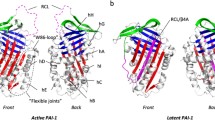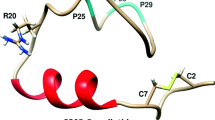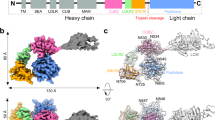Abstract
Serine protease inhibitor Kazal type 1 (SPINK1) plays an important role in protecting the pancreas against premature trypsinogen activation that causes pancreatitis. Various mutations in the SPINK1 gene were shown to be associated with patients with pancreatitis. Recent transfection studies identified intracellular folding defects, probably caused by mutation induced misfolding of D50E and Y54H mutations, as a common mechanism that reduces SPINK1 secretion and as a possible novel mechanism of SPINK1 deficiency associated with chronic pancreatitis. Using molecular dynamics, we investigated the effects of D50E and Y54H mutations on SPINK1 dynamics and conformation at 300 K. We found that the structures of D50E and Y54H mutants were less stable than and were distorted from those of the wild type, as indicated by the RMSD plots, RMSF plots and DSSP series. Specifically, unwinding of the top of helices (the main secondary structures) and the distortion of the loops above the helices were observed. It may be possible that this distorted protein structure may be recognized as “non-native” by members of the chaperone family; it may be further retained and targeted for degradation, leading to SPINK1 secretion reduction and subsequently pancreatitis in patients as Király et al. (Gut 56:1433, 2007) proposed.









Similar content being viewed by others
References
Ohmuraya M, Yamamura K (2011) The roles of serine protease inhibitor kazal type 1 (spink1) in pancreatic diseases. Exp Anim Tokyo 60:433–444
Rinderknecht H (1986) Activation of pancreatic zymogens. Digest Dis Sci 31:314–321
Bhatia E, Choudhuri G, Sikora SS, Landt O, Kage A, Becker M, Witt H (2002) Tropical calcific pancreatitis: strong association with spink1 trypsin inhibitor mutations. Gastroenterology 123:1020–1025
Chandak G, Idris M, Reddy D, Bhaskar S, Sriram P, Singh L (2002) Mutations in the pancreatic secretory trypsin inhibitor gene (psti/spink1) rather than the cationic trypsinogen gene (prss1) are significantly associated with tropical calcific pancreatitis. J Med Genet 39:347–351
Chen JM, Mercier B, Audrezet MP, Raguenes O, Quere I, Ferec C (2001) Mutations of the pancreatic secretory trypsin inhibitor (psti) gene in idiopathic chronic pancreatitis. Gastroenterology 120:1061
Drenth J, Te Morsche R, Jansen J (2002) Mutations in serine protease inhibitor kazal type 1 are strongly associated with chronic pancreatitis. Gut 50:687
Hassan Z, Mohan V, Ali L, Allotey R, Barakat K, Faruque MO, Deepa R, McDermott MF, Jackson AE, Cassell P (2002) SPINK1 is a susceptibility gene for fibrocalculous pancreatic diabetes in subjects from the indian subcontinent. Am J Hum Genet 71:964–968
Noone PG, Zhou Z, Silverman LM, Jowell PS, Knowles MR, Cohn JA (2001) Cystic fibrosis gene mutations and pancreatitis risk: relation to epithelial ion transport and trypsin inhibitor gene mutations. Gastroenterology 121:1310–1319
Pfützer RH, Barmada MM, Brunskill APJ, Finch R, Hart PS, Neoptolemos J, Furey WF, Whitcomb DC (2000) Spink1/psti polymorphisms act as disease modifiers in familial and idiopathic chronic pancreatitis. Gastroenterology 119:615–623
Plendl H, Siebert R, Steinemann D, Grote W (2001) High frequency of the n34s mutation in the spink1 gene in chronic pancreatitis detected by a new pcr–rflp assay. Am J Med Genet 100:252–253
Schneider A, Suman A, Rossi L, Barmada MM, Beglinger C, Parvin S, Sattar S, Ali L, Khan A, Gyr N (2002) Spink1/psti mutations are associated with tropical pancreatitis and type ii diabetes mellitus in bangladesh. Gastroenterology 123:1026–1030
Threadgold J, Greenhalf W, Ellis I, Howes N, Lerch M, Simon P, Jansen J, Charnley R, Laugier R, Frulloni L (2002) The n34s mutation of spink1 (psti) is associated with a familial pattern of idiopathic chronic pancreatitis but does not cause the disease. Gut 50:675
Truninger K, Witt H, Köck J, Kage A, Seifert B, Ammann RW, Blum HE, Becker M (2002) Mutations of the serine protease inhibitor, kazal type 1 gene, in patients with idiopathic chronic pancreatitis. Am J Gastroenterol 97:1133–1137
Weiss FU, Simon P, Bogdanova N, Mayerle J, Dworniczak B, Horst J, Lerch MM (2005) Complete cystic fibrosis transmembrane conductance regulator gene sequencing in patients with idiopathic chronic pancreatitis and controls. Gut 54:1456
Witt H, Luck W, Hennies HC, Claßen M, Kage A, Laß U, Landt O, Becker M (2000) Mutations in the gene encoding the serine protease inhibitor, kazal type 1 are associated with chronic pancreatitis. Nat Genet 25:213–216
Ockenga J, Dork T, Stuhrmann M (2001) Low prevalence of spink1 gene mutations in adult patients with chronic idiopathic pancreatitis. J Med Genet 38:243–244
Hirota M, Kuwata K, Ohmuraya M, Ogawa M (2003) From acute to chronic pancreatitis: the role of mutations in the pancreatic secretory trypsin inhibitor gene. JOP 4:83–88
Kuwata K, Hirota M, Nishimori I, Otsuki M, Ogawa M (2003) Mutational analysis of the pancreatic secretory trypsin inhibitor gene in familial and juvenile pancreatitis in japan. J Gastroenterol 38:365–370
Kuwata K, Hirota M, Sugita H, Kai M, Hayashi N, Nakamura M, Matsuura T, Adachi N, Nishimori I, Ogawa M (2001) Genetic mutations in exons 3 and 4 of the pancreatic secretory trypsin inhibitor in patients with pancreatitis. J Gastroenterol 36:612–618
Lowenfels AB, Maisonneuve P, Cavallini G, Ammann RW, Lankisch PG, Andersen JR, Dimagno EP, Andren-Sandberg A, Domellof L (1993) Pancreatitis and the risk of pancreatic cancer. New Engl J Med 328:1433–1437
Malka D, Hammel P, Maire F, Rufat P, Madeira I, Pessione F, Levy P, Ruszniewski P (2002) Risk of pancreatic adenocarcinoma in chronic pancreatitis. Gut 51:849
Lowenfels AB, Maisonneuve P, DiMagno EP, Elitsur Y, Gates LK Jr, Perrault J, Whitcomb DC (1997) Hereditary pancreatitis and the risk of pancreatic cancer. J Natl Cancer Inst 89:442–446
Király O, Wartmann T, Sahin-Tóth M (2007) Missense mutations in pancreatic secretory trypsin inhibitor (spink1) cause intracellular retention and degradation. Gut 56:1433
Chaudhuri TK, Paul S (2006) Protein–misfolding diseases and chaperone–based therapeutic approaches. FEBS J 273:1331–1349
Welch WJ (2004) Role of quality control pathways in human diseases involving protein misfolding. Semin Cell Dev Biol 15:31–38
Carrell RW, Gooptu B (1998) Conformational changes and disease—serpins, prions and alzheimer’s. Curr Opin Struc Biol 8:799–809
Hecht H, Szardenings M, Collins J, Schomburg D (1992) Three-dimensional structure of a recombinant variant of human pancreatic secretory trypsin inhibitor (kazal type). J Mol Biol 225:1095–1103
Accelrys Inc. Discovery studio 2.5 package, San Diego, CA
Case DA, Cheatham TE III, Darden T, Gohlke H, Luo R, Merz KM Jr, Onufriev A, Simmerling C, Wang B, Woods RJ (2005) The amber biomolecular simulation programs. J Comput Chem 26:1668–1688
Case DA, Darden TA, Cheatham TE III, Simmerling C, Wang J (2008) Amber 10, San Francisco
Duan Y, Wu C, Chowdhury S, Lee MC, Xiong G, Zhang W, Yang R, Cieplak P, Luo R, Lee T (2003) A point–charge force field for molecular mechanics simulations of proteins based on condensed–phase quantum mechanical calculations. J Comput Chem 24:1999–2012
Cerutti DS, Duke R, Freddolino PL, Fan H, Lybrand TP (2008) A vulnerability in popular molecular dynamics packages concerning langevin and andersen dynamics. J Chem Theor Comput 4:1669–1680
Ryckaert JP, Ciccotti G, Berendsen HJC (1977) Numerical integration of the cartesian equations of motion of a system with constraints: molecular dynamics of n-alkanes. J Comput Phys 23:327–341
Kabsch W, Sander C (1983) Dictionary of protein secondary structure: pattern recognition of hydrogen–bonded and geometrical features. Biopolymers 22:2577–2637
Acknowledgments
The authors would like to thank the National Center for Genetic Engineering and Biotechnology (BIOTEC) and the National Science and Technology Development Agency (NSTDA) for the use of high performance computer clusters. The National Nanotechnology Center (NANOTEC) for the use of Discovery Studio. Mr. Chumpol Ngamphiw for his technical supports on the clusters. Mr. Pongsakorn Wangkumhang and Mr. Supasak Kulawonganunchai for helpful technical discussions. This work was supported by the Office of the Higher Education Commission and Mahidol University under the National Research Universities Initiative, the Thailand Research Fund (TRF) under Project no. RSA5480026, the “Research Chair Grant” National Science and Technology Development Agency, and the Higher Education Research Promotion and National Research University Project of Thailand, the Office of the Higher Education Commission.
Author information
Authors and Affiliations
Corresponding authors
Additional information
Wanwimon Mokmak and Surasak Chunsrivirot contributed equally to this work
Electronic supplementary material
Below is the link to the electronic supplementary material.
Fig. S1
RMSD of the models of wild type, D50E, Y54H(δ) and Y54H(ε) mutants of the second and third runs (excluding the flexible N-terminals). (a) wild type 2, (b) wild type 3, (c) D50E 2, (d) D50E 3, (e) Y54H(δ) 2, (f) Y54H(δ) 3, (g) Y54H(ε) 2, (h) Y54H(ε) 3. (JPEG 112 kb)
High resolution image
(TIFF 366 kb)
Fig. S2
RMS fluctuation of the models of wild type, D50E, Y54H(δ) and Y54H(ε) mutants of the second and third runs. (a) wild type 2, (b) wild type 3, (c) D50E 2, (d) D50E 3, (e) Y54H(δ) 2, (f) Y54H(δ) 3, (g) Y54H(ε) 2, (h) Y54H(ε) 3. (JPEG 74 kb)
High resolution image
(TIFF 198 kb)
Fig. S3
Secondary structure as a function of simulation time (as determine by DSSP) of the second and third runs. The arrows indicate the points where helices H start to unwind. (a) wild type 2 (b) wild type 3, (c) D50E 2 (d) D50E 3, (e) Y54H(δ) 2, (f) Y54H(δ) 3, (g) Y54H(ε) 2, (h) Y54H(ε) 3. (JPEG 304 kb)
High resolution image
(TIFF 727 kb)
Fig. S4
Front views of the structures of the wild type and mutants after 50 ns simulations of the second run. Important residues are shown in licorice. Unwinding of the top of the main helices H is circled in red. Important hydrogen bonds are shown as green dashed lines. (a) wild type, (b) D50E, (c) Y54H(δ), (d) Y54H(ε). (JPEG 97 kb)
High resolution image
(TIFF 734 kb)
Fig. S5
Back views of the structures of the wild type and mutants after 50 ns simulations of the second run. Important residues are shown in licorice. Important hydrogen bonds are shown as green dashed lines. The absences of hydrogen bonds between the backbone carbonyl oxygens of Asn64 and the backbone amino hydrogens of Gln68 are circled in red. (a) wild type, (b) D50E, (c) Y54H(δ), (d) Y54H(ε). (JPEG 90 kb)
High resolution image
(TIFF 724 kb)
Fig. S6
Front views of the structures of the wild type and mutants after 50 ns simulations of the third run. Important residues are shown in licorice. Unwinding of the top of the main helices H is circled in red. Important hydrogen bonds are shown as green dashed lines. (a) wild type, (b) D50E, (c) Y54H(δ), (d) Y54H(ε). (JPEG 97 kb)
High resolution image
(TIFF 746 kb)
Fig. S7
Back views of the structures of the wild type and mutants after 50 ns simulations of the third run. Important residues are shown in licorice. Important hydrogen bonds are shown as green dashed lines. The absences of hydrogen bonds between the backbone carbonyl oxygens of Asn64 and the backbone amino hydrogens of Gln68 are circled in red. (a) wild type, (b) D50E, (c) Y54H(δ), (d) Y54H(ε). (JPEG 92 kb)
High resolution image
(TIFF 762 kb)
Fig. S8
Hydrogen bond distance profiles of the second and third runs between backbone oxygen of the carbonyl group of Asn64 and backbone hydrogen of the amino group of Gln68. (a) wild type 2, (b) wild type 3, (c) D50E 2, (d) D50E 3, (e) Y54H(δ) 2, (f) Y54H(δ) 3, (g) Y54H(ε) 2, (h) Y54H(ε) 3. (JPEG 99 kb)
High resolution image
(TIFF 309 kb)
Rights and permissions
About this article
Cite this article
Mokmak, W., Chunsrivirot, S., Assawamakin, A. et al. Molecular dynamics simulations reveal structural instability of human trypsin inhibitor upon D50E and Y54H mutations. J Mol Model 19, 521–528 (2013). https://doi.org/10.1007/s00894-012-1565-2
Received:
Accepted:
Published:
Issue Date:
DOI: https://doi.org/10.1007/s00894-012-1565-2




